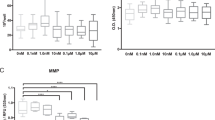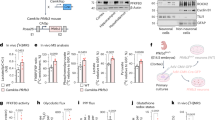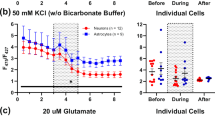Abstract
Aim:
To investigate the effects of pyrroloquinoline quinone (PQQ), an oxidoreductase cofactor, on high glucose-induced mouse endothelial cell damage in vitro.
Methods:
Mouse brain microvascular endothelial bEND.3 cells were exposed to different glucose concentrations (5.56, 25 and 40 mmol/L) for 24 or 48 h. The cell viability was examined using MTT assay. Flow cytometry was used to analyze the apoptosis and ROS levels in the cells. MitoTracker Green staining was used to examine the mitochondria numbers in the cells. Western blot analysis was used to analyze the expression of HIF-1α and the proteins in JNK pathway.
Results:
Treatment of bEND.3 cells with high glucose significantly decreased the cell viability, while addition of PQQ (1 and 10 μmol/L) reversed the high glucose-induced cell damage in a concentration-dependent manner. Furthermore, PQQ (100 μmol/L) significantly suppressed the high glucose-induced apoptosis and ROS production in the cells. PQQ significantly reversed the high glucose-induced reduction in both the mitochondrial membrane potential and mitochondria number in the cells. The high glucose treatment significantly increased the expression of HIF-1α and JNK phosphorylation in the cells, and addition of PQQ led to a further increase of HIF-1α level and a decrease of JNK phosphorylation. Addition of JNK inhibitor SP600125 (10 μmol/L) also significantly suppressed high glucose-induced apoptosis and JNK phosphorylation in bEND.3 cells.
Conclusion:
PQQ protects mouse brain endothelial cells from high glucose damage in vitro by suppressing intracellular ROS and apoptosis via inhibiting JNK signaling pathway.
Similar content being viewed by others
Log in or create a free account to read this content
Gain free access to this article, as well as selected content from this journal and more on nature.com
or
Accession codes
References
Salvado L, Serrano-Marco L, Barroso E, Palomer X, Vazquez-Carrera M . Targeting PPARbeta/delta for the treatment of type 2 diabetes mellitus. Expert Opin Ther Targets 2012; 16: 209–23.
Lui MM, Sau-Man M . OSA and atherosclerosis. J Thorac Dis 2012; 4: 164–72.
Garabedian T, Alam S . High residual platelet reactivity on clopidogrel: its significance and therapeutic challenges overcoming clopidogrel resistance. Cardiovasc Diagn Ther 2013; 3: 23–37.
Kishida K, Funahashi T, Shimomura I . Molecular mechanisms of diabetes and atherosclerosis: Role of adiponectin. Endocr Metab Immune Disord Drug Targets 2012; 12: 118–31.
Pandey A, Tripathi P, Pandey R, Srivatava R, Goswami S . Alternative therapies useful in the management of diabetes: A systematic review. J Pharm Bioallied Sci 2011; 3: 504–12.
Nakao YM, Teramukai S, Tanaka S, Yasuno S, Fujimoto A, Kasahara M, et al. Effects of renin-angiotensin system blockades on cardiovascular outcomes in patients with diabetes mellitus: A systematic review and meta-analysis. Diabetes Res Clin Pract 2011; 96: 68–75.
Cubbon RM, Ali N, Sengupta A, Kearney MT . Insulin- and growth factor-resistance impairs vascular regeneration in diabetes mellitus. Curr Vasc Pharmacol 2012; 10: 271–84.
Yoshikawa Y, Yasui H . Zinc complexes developed as metallopharmaceutics for treating diabetes mellitus based on the bio-medicinal inorganic chemistry. Curr Top Med Chem 2012; 12: 210–8.
Mitic T, Emanueli C . Diabetes-induced epigenetic signature in vascular cells. Endocr Metab Immune Disord Drug Targets 2012; 12: 107–17.
Tousoulis D, Briasoulis A, Papageorgiou N, Tsioufis C, Tsiamis E, Toutouzas K, et al. Oxidative stress and endothelial function: therapeutic interventions. Recent Pat Cardiovasc Drug Discov 2011; 6: 103–14.
Zhang Y, Du Y, Le W, Wang K, Kieffer N, Zhang J . Redox control of the survival of healthy and diseased cells. Antioxid Redox Signal 2011; 15: 2867–908.
Thomas MC . Advanced glycation end products. Contrib Nephrol 2011; 170: 66–74.
Zong H, Ward M, Stitt AW . AGEs, RAGE, and diabetic retinopathy. Curr Diab Rep 2011; 11: 244–52.
Vassort G, Turan B . Protective role of antioxidants in diabetes-induced cardiac dysfunction. Cardiovasc Toxicol 2010; 10: 73–86.
Shen GX . Oxidative stress and diabetic cardiovascular disorders: roles of mitochondria and NADPH oxidase. Can J Physiol Pharmacol 2010; 88: 241–8.
Toda N, Nakanishi-Toda M . Nitric oxide: ocular blood flow, glaucoma, and diabetic retinopathy. Prog Retin Eye Res 2007; 26: 205–38.
Potenza MA, Gagliardi S, Nacci C, Carratu MR, Montagnani M . Endothelial dysfunction in diabetes: from mechanisms to therapeutic targets. Curr Med Chem 2009; 16: 94–112.
Rucker R, Chowanadisai W, Nakano M . Potential physiological importance of pyrroloquinoline quinone. Altern Med Rev 2009; 14: 268–77.
Holscher T, Schleyer U, Merfort M, Bringer-Meyer S, Gorisch H, Sahm H . Glucose oxidation and PQQ-dependent dehydrogenases in Gluconobacter oxydans. J Mol Microbiol Biotechnol 2009; 16: 6–13.
Yamada M, Elias MD, Matsushita K, Migita CT, Adachi O . Escherichia coli PQQ-containing quinoprotein glucose dehydrogenase: its structure comparison with other quinoproteins. Biochim Biophys Acta 2003; 1647: 185–92.
Yakushi T, Matsushita K . Alcohol dehydrogenase of acetic acid bacteria: structure, mode of action, and applications in biotechnology. Appl Microbiol Biotechnol 2010; 86: 1257–65.
Gomez-Manzo S, Contreras-Zentella M, Gonzalez-Valdez A, Sosa-Torres M, Arreguin-Espinoza R, Escamilla-Marvan E . The PQQ-alcohol dehydrogenase of Gluconacetobacter diazotrophicus. Int J Food Microbiol 2008; 125: 71–8.
Misra HS, Khairnar NP, Barik A, Indira Priyadarsini K, Mohan H, Apte SK . Pyrroloquinoline-quinone: a reactive oxygen species scavenger in bacteria. FEBS Lett 2004; 578: 26–30.
Szabo C . Roles of hydrogen sulfide in the pathogenesis of diabetes mellitus and its complications. Antioxid Redox Signal 2012; 17: 68–80.
Tousoulis D, Kampoli AM, Tentolouris C, Papageorgiou N, Stefanadis C . The role of nitric oxide on endothelial function. Curr Vasc Pharmacol 2011; 10: 4–18.
Watanabe K, Thandavarayan RA, Harima M, Sari FR, Gurusamy N, Veeraveedu PT, et al. Role of differential signaling pathways and oxidative stress in diabetic cardiomyopathy. Curr Cardiol Rev 2011; 6: 280–90.
Onat D, Brillon D, Colombo PC, Schmidt AM . Human vascular endothelial cells: a model system for studying vascular inflammation in diabetes and atherosclerosis. Curr Diab Rep 2011; 11: 193–202.
van den Oever IA, Raterman HG, Nurmohamed MT, Simsek S . Endothelial dysfunction, inflammation, and apoptosis in diabetes mellitus. Mediators Inflamm 2010; 2010: 792393.
Yoon JW, Cho BJ, Park HS, Kang SM, Choi SH, Jang HC, et al. Differential effects of trimetazidine on vascular smooth muscle cell and endothelial cell in response to carotid artery balloon injury in diabetic rats. Int J Cardiol 2012; 167: 126–33.
Xie Y, You SJ, Zhang YL, Han Q, Cao YJ, Xu XS, et al. Protective role of autophagy in AGE-induced early injury of human vascular endothelial cells. Mol Med Report 2011; 4: 459–64.
Zhang Z, Liew CW, Handy DE, Zhang Y, Leopold JA, Hu J, et al. High glucose inhibits glucose-6-phosphate dehydrogenase, leading to increased oxidative stress and beta-cell apoptosis. FASEB J 2010; 24: 1497–505.
Bento CF, Pereira P . Regulation of hypoxia-inducible factor 1 and the loss of the cellular response to hypoxia in diabetes. Diabetologia 2011; 54: 1946–56.
Yan J, Zhang Z, Shi H . HIF-1 is involved in high glucose-induced paracellular permeability of brain endothelial cells. Cell Mol Life Sci 2012; 69: 115–28.
Zhang S, Chen X, Yang Y, Zhou X, Liu J, Ding F . Neuroprotection against cobalt chloride-induced cell apoptosis of primary cultured cortical neurons by salidroside. Mol Cell Biochem 2011; 354: 161–70.
Zhang L, Pang S, Deng B, Qian L, Chen J, Zou J, et al. High glucose induces renal mesangial cell proliferation and fibronectin expression through JNK/NF-kappaB/NADPH oxidase/ROS pathway, which is inhibited by resveratrol. Int J Biochem Cell Biol 2012; 44: 629–38.
Nishikawa T, Araki E . Impact of mitochondrial ROS production in the pathogenesis of diabetes mellitus and its complications. Antioxid Redox Signal 2007; 9: 343–53.
Ho SY, Wu WJ, Chiu HW, Chen YA, Ho YS, Guo HR, et al. Arsenic trioxide and radiation enhance apoptotic effects in HL-60 cells through increased ROS generation and regulation of JNK and p38 MAPK signaling pathways. Chem Biol Interact 2011; 193: 162–71.
Author information
Authors and Affiliations
Corresponding author
Rights and permissions
About this article
Cite this article
Wang, Z., Chen, Gq., Yu, Gp. et al. Pyrroloquinoline quinone protects mouse brain endothelial cells from high glucose-induced damage in vitro. Acta Pharmacol Sin 35, 1402–1410 (2014). https://doi.org/10.1038/aps.2014.4
Received:
Accepted:
Published:
Issue date:
DOI: https://doi.org/10.1038/aps.2014.4
Keywords
This article is cited by
-
Confocal imaging dataset to assess endothelial cell orientation during extreme glucose conditions
Scientific Data (2022)
-
Brain microvasculature endothelial cell orientation on micropatterned hydrogels is affected by glucose level variations
Scientific Reports (2021)
-
Overexpression of calcitonin gene-related peptide protects mouse cerebral microvascular endothelial cells from high-glucose-induced damage via ERK/HIF-1/VEGF signaling
The Journal of Physiological Sciences (2019)



